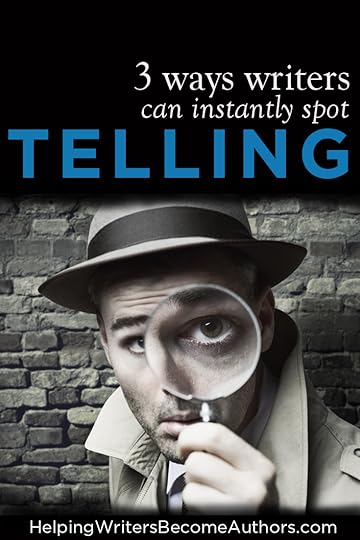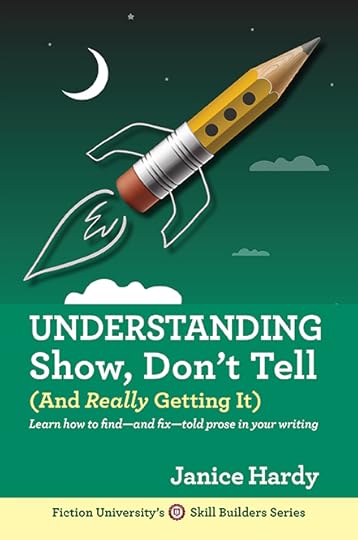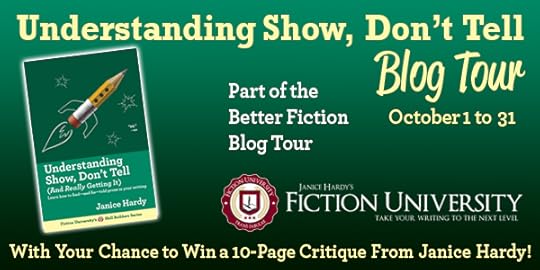3 Ways Writers Can Instantly Spot Telling

Show, don’t tell is a broad concept, which is why one rule doesn’t cover it all. It’s subjective, and each telling instance found in your writing must be evaluated in context.
Does this sentence sound like telling? Is this scene explaining too much? But if you look at only the text, you risk missing “told prose” in your writing, since a sentence that technically shows can feel told. It’s important to examine the different levels of telling so you know what to look for.
Here are three.
1. Telling at the Sentence Level
You’ll find most telling at the sentence level. Most of these types of tells can be caught by searching for common red flag words, such as because, since, or when.
Keep in mind “tell” is subjective. A sentence can tell and still read and work fine. It’s up to you to decide if the sentence would be stronger with or without the telling. Such tells include:
Telling That Explains
These explain the reasons why characters feel or act as they do. They also sneak in when you fear the text isn’t clear enough and you have to explain information so readers “get it.”
Telling That Summarizes
These tells take a shortcut by summarizing instead of dramatizing. They often read as though someone is watching the scene unfold from the sidelines, giving a general overview of the action. They might even sound like a summary you’d find in an outline instead of a novel.
Telling That Conveys Information
Many tells exist only to convey information the characters would never think (or have reason) to share, such as world-building details or character backstories. They often sound too self-aware, or read as if the author was jumping into the story with a mini-lecture.
2. Telling at the Paragraph Level
If the told prose is explaining or summarizing a situation, the telling can affect an entire paragraph or even a page. You’ll find these tells most often when you pull away from the point-of-view character and start describing what’s going on from afar. These told sections can read like a summary of the scene in your outline. It might even read as if you planned to do more, but never got around to it.
Info-Dump Telling
An info dump often drops in the reasons why something is important in the overall world or setting of the story. Infodumps focus almost exclusively on information relating to the world. This is information readers “need” to understand the story.
Backstory Telling
These tells explain the history of a character, place, or item and why it’s important. Frequently, they’re more extensive than an info dump, sometimes using flashbacks and long internal monologues to reveal the often unnecessary history. Backstory tells focus exclusively on the histories of the characters, explaining why characters are the way they are.
3. Telling at the Scene Level
Telling doesn’t stop with summarized paragraphs. It’s possible to tell an entire scene. These are some of the sneakier types of tells, because writers rarely think to look for told prose at this level. This is a scene that contains important information, but in which you don’t show the scene unfolding.
The most common scene-level tell are flashbacks. They use an entire scene to dump history or explain backstory, since showing the scene might actually stop the story. Flashbacks are particularly tricky because they’re often shown, but they’re still telling readers information.
What’s annoying about these tells is that technically, they’re not traditional tells. They just read as though the author is summarizing or explaining events in the novel while nothing is happening on the page. Readers get bored, skim through them, and complain nothing happened in the novel. Since these scenes look like solid, functioning scenes, authors are left scratching their heads and wondering what’s wrong and why no one wants the book.
What Are You Trying to Tell Your Readers?
No matter where you find your told prose, before you revise it, take a step back and consider: What are you trying to tell your readers? Once you pinpoint what’s important and what needs to be conveyed, you’ll be better able to choose how to show that information. Look for ways to:
Suggest motives through what a character does, says, or thinks.
Show world-building rules through how those rules and details affect the character’s actions.
Show character backstory by choosing details and actions that had an influence on someone who lived through that history.
Show, don’t tell is a troublesome beast, but it’s a tool like any other. If you think about how you want to use it and what you’re trying to say, you’ll have a much better sense of how to convey that information to your readers.
Win a 10-Page Critique From Janice Hardy
 Check out my new book, Understanding Show, Don’t Tell (And Really Getting it), and learn what show, don’t tell means, how to spot told prose in your writing, and why common advice on how to fix it doesn’t always work.
Check out my new book, Understanding Show, Don’t Tell (And Really Getting it), and learn what show, don’t tell means, how to spot told prose in your writing, and why common advice on how to fix it doesn’t always work.
Three Books. Three Months. Three Chances to Win.
To celebrate the release of my newest writing books, I’m going on a three-month blog tour—and each month, one lucky winner will receive a 10-page critique from me.
It’s easy to enter. Simply visit leave a comment and enter the drawing via Rafflecopter. At the end of each month, I’ll randomly choose a winner.

Wordplayers, tell me your opinion! Have you every struggled with show, don’t tell? Tell me in the comments!
The post 3 Ways Writers Can Instantly Spot Telling appeared first on Helping Writers Become Authors.



